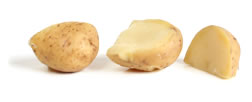Seder Plate: The VegetableA non-bitter root vegetable alludes to the back-breaking work of the Jews as slaves. The Hebrew letters of karpas can be arranged to spell "Perach Samech". 
Perach means
backbreaking work and Samech is numerically
equivalent to 60, referring to the 60 myriads
(10,000), equaling 600,000, which was the number of
Jewish males over 20 years of age who were enslaved
in Egypt.
Preparation: Role in the
Seder: Then the head of the household cuts a small piece of the root vegetable used, dips it in salt water, and gives each person at the table a very small piece over which they say the appropriate blessing. Care should be taken that each person eats less than 17 grams ( 1/2 ounce). | |
|
|
